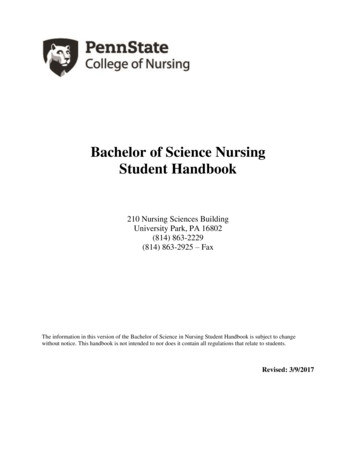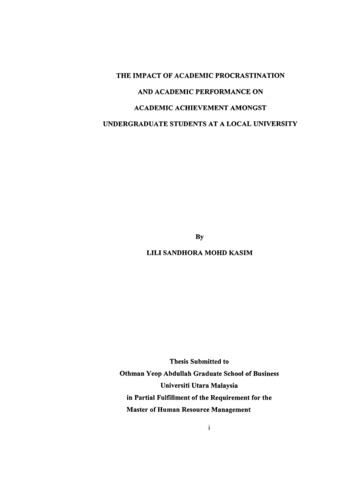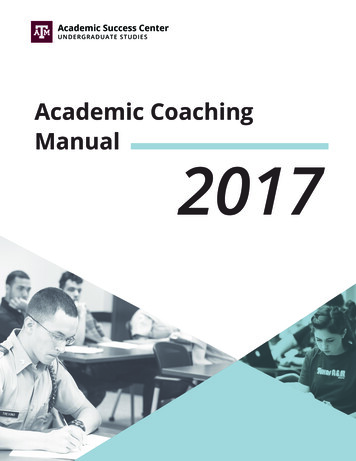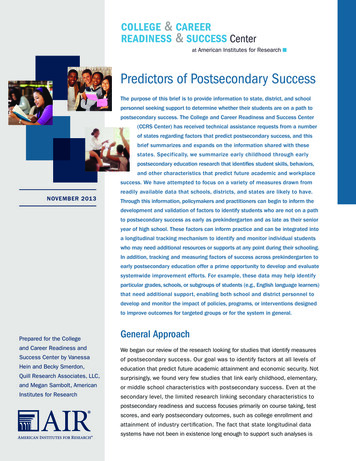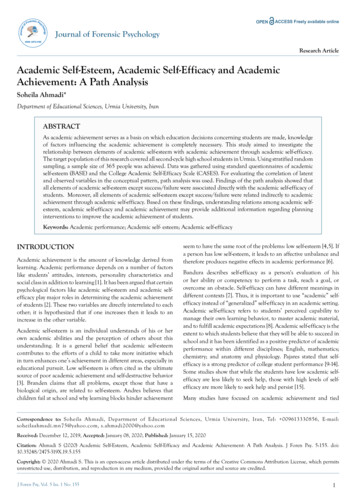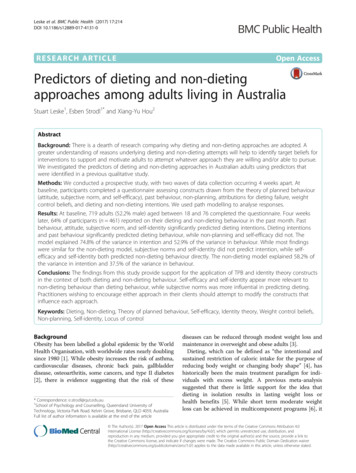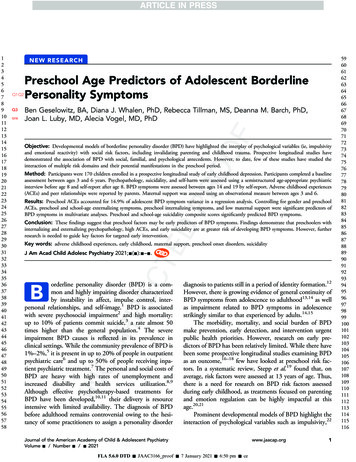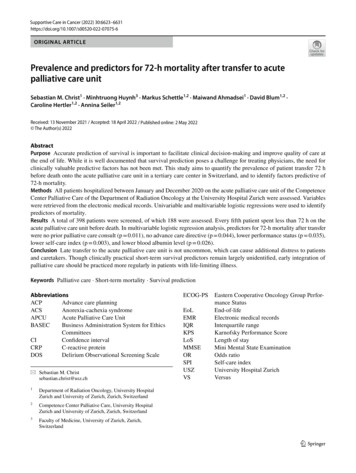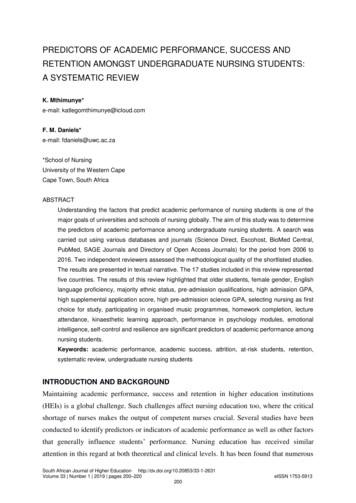
Transcription
PREDICTORS OF ACADEMIC PERFORMANCE, SUCCESS ANDRETENTION AMONGST UNDERGRADUATE NURSING STUDENTS:A SYSTEMATIC REVIEWK. Mthimunye*e-mail: katlegomthimunye@icloud.comF. M. Daniels*e-mail: fdaniels@uwc.ac.za*School of NursingUniversity of the Western CapeCape Town, South AfricaABSTRACTUnderstanding the factors that predict academic performance of nursing students is one of themajor goals of universities and schools of nursing globally. The aim of this study was to determinethe predictors of academic performance among undergraduate nursing students. A search wascarried out using various databases and journals (Science Direct, Escohost, BioMed Central,PubMed, SAGE Journals and Directory of Open Access Journals) for the period from 2006 to2016. Two independent reviewers assessed the methodological quality of the shortlisted studies.The results are presented in textual narrative. The 17 studies included in this review representedfive countries. The results of this review highlighted that older students, female gender, Englishlanguage proficiency, majority ethnic status, pre-admission qualifications, high admission GPA,high supplemental application score, high pre-admission science GPA, selecting nursing as firstchoice for study, participating in organised music programmes, homework completion, lectureattendance, kinaesthetic learning approach, performance in psychology modules, emotionalintelligence, self-control and resilience are significant predictors of academic performance amongnursing students.Keywords: academic performance, academic success, attrition, at-risk students, retention,systematic review, undergraduate nursing studentsINTRODUCTION AND BACKGROUNDMaintaining academic performance, success and retention in higher education institutions(HEIs) is a global challenge. Such challenges affect nursing education too, where the criticalshortage of nurses makes the output of competent nurses crucial. Several studies have beenconducted to identify predictors or indicators of academic performance as well as other factorsthat generally influence students’ performance. Nursing education has received similarattention in this regard at both theoretical and clinical levels. It has been found that numerousSouth African Journal of Higher Education http://dx.doi.org/10.20853/33-1-2631Volume 33 Number 1 2019 pages 200‒220200eISSN 1753-5913
Mthimunye and DanielsPredictors of academic performance, success and retentionfactors can forecast a student’s academic performance. These factors may be of vital importanceto HEIs as well as to nurse educators in identifying students who may be at risk of unsatisfactoryacademic performance, which limits the students’ academic potential. Identification of thesefactors may help to reduce the attrition rate and improve the graduate output rate, thusalleviating nursing staff shortages at national and global levels.The World Health Organization (WHO) estimates that there is a worldwide shortage ofapproximately 4.3 million doctors, midwives, nurses and other healthcare professionals (WorldHealth Organization 2010). Buerhaus, Auerbach and Staiger (2009, w657‒668) reported thatthe demand for qualified nurse practitioners was increasing at a rate of 2–3 per cent per year.To alleviate the nursing workforce shortage, the intake of nursing students needs to increase. In2015, it was estimated that the South African Nursing Council (SANC) registered a total of20 549 nursing students for undergraduate nursing programmes at South African universitiesand nursing colleges. Of the 20 549 students, 3 808 (18.53%) were first admissions (first-yearnursing students) and 16 471 (81.47%) were re-admissions (second-year to final-year students)(SANC 2016). Most nursing schools are dependent on specific admission criteria, based onprevious studies, to select high-quality prospective students who have high potential ofacademic success in the nursing profession. However, the selection criteria and admissionrequirements of nursing students in South Africa (SA) and worldwide have come under intensescrutiny in recent years, possibly owing to growing levels of attrition and continued globalshortages (Newton and Moore 2009, 273‒278; McNelis et al. 2010, 188‒195; Smith 2016, 215‒218). Some authors have claimed that contextual indicators and factors such as previousacademic performance, age, gender and ethnicity are significant determining parameters ofacademic success in training nurses (Schmidt and MacWilliams 2011, 171‒174; Jeffreys 2012;Beauvais et al. 2014, 918‒923; Mthimunye, Daniels and Pedro 2015).A more comprehensive and systematic review of the factors that predict academicperformance, success and retention of undergraduate nursing students (UNs) is required toensure appropriate ways of enhancing nursing education so as to produce a cadre of nurses whowill boost human resources for health. The current article presents the findings of a systematicreview based on the Nursing Universal Retention and Success (NURS) model of Jeffreys(2015).METHODSThe review aimed to systematically locate, appraise the quality of, and synthesise academicstudies proposing likely predictors of academic performance amongst UNs. The main researchquestion addressed was: What are the predictors of academic performance and success as wellas the factors that may affect the retention of UNs? Cochrane guidelines for systematic reviews201
Mthimunye and DanielsPredictors of academic performance, success and retentionwere used to guide this review (Higgins and Green 2011). After formulating the researchquestion, systematic and explicit methods were used to identify, select and critically evaluatethe quality of relevant research reports from major educational databases.Electronic search strategyIn addressing the predictors of academic success and retention amongst nursing students, asearch was conducted in January 2017 of databases and journals such as Science Direct,Escohost (Eric, Academic Search Complete, PsycARTICLES, Education Search Complete,Health Source: Nursing/Academic Edition), BioMed Central, PubMed, SAGE Journals andDirectory of Open Access Journal (DOAJ) for the period 2006 to 2016. Keywords used in thesearch included predictors of academic performance, predictors of academic success andnursing students. The primary researcher conducted an initial search and reviewed the titles,abstracts and articles. The initial search generated 522 articles. The next phase involvedeliminating duplications, which left 444 retrieved articles. Eight additional studies wereconsidered for possible inclusion, which were obtained from other sources and from referencelists of other articles, increasing the number of studies to 452.Criteria for considering studies for review (inclusion criteria)Studies were included if they met the following criteria: (1) full-text quantitative study inEnglish; (2) prospective and retrospective cohort studies, case-control studies and crosssectional studies; (3) UNs were included as part of the sample; (4) primary outcome of interestwas predictors of academic performance, success and retention amongst B.Nurs students.Secondary outcomes included factors that influenced academic performance and success; and(5) the papers were published between 2006 and 2016. Globally, the major developments innursing education over the last decade have been in addressing nurse shortages, improving thestatus of nursing education, and improving the quality of nurses produced.Study selectionThree instruments were used to ensure rigorous screening of the research studies and to ensurethat all relevant data were collected. Firstly, the Title Reading and Extraction Tool (TRET) wasused to select journal articles for inclusion based on the relevance of the title. A sample of 42studies was reached, based on title reading. Secondly, the Abstract Reading Extraction Tool(ARET) was used to assess the relevance of selected journal articles for inclusion based on therelevance of the abstract. Following title reading, the abstracts of the studies were reviewed foreligibility and a sample of 20 studies was identified and retrieved. Thirdly, the QualityAssessment Tool (QAT) was used by one of the reviewers after the retrieval where possible offull-text articles to investigate their quality. The same process was then followed by another202
Mthimunye and DanielsPredictors of academic performance, success and retentionreviewer to determine whether the article adequately met the criteria for inclusion in the review.Any discrepancies were adjudicated and agreement reached by consensus.Methodological quality appraisalA quality assessment tool for quantitative studies developed by the Effective Public HealthPractice Project (EPHPP) was adapted to fit the current review (Thomas 2003). The QAT wasadopted from previous studies (Armijo‐Olivo et al. 2012, 12‒18; Puertas, Arósquipa andGutiérrez 2013, 351‒358; Bassir et al. 2014, 98‒109). This tool assesses aspects of themethodologies employed and gives scores on a Likert-type scale. Following the qualityappraisal of eligible studies, three studies were excluded owing to their overall weak rating.Therefore, the final sample consisted of 17 articles which were included in the systematicIdentificationreview. Figure 1 outlines the process involved in the systematic review.Number of records identified through asystematic search (N 522)Number of additional records identifiedthrough other sources (n 8)IncludedEligibilityScreeningNumber of records after duplicates removed(n 452)Number of records screened(n 452)Number of recordsexcluded (n 410)Number of full-text articlesassessed for eligibility (n 42)Number of articlesexcluded on readingfull-text (n 22)Number of articles assessedfor quality (n 20)Number of articlesexcluded on criticalappraisal (n 3)Number of articles included(n 17)Figure 1: Flow chart of study screening process.203
Mthimunye and DanielsPredictors of academic performance, success and retentionData extraction and synthesisAfter completion of the methodological quality appraisal, studies that met the criteria for thecategories of “strong” to “moderate” were reviewed, and a data extraction tool was used toensure that all relevant data were extracted from the selected articles. Table 1 comprisesrelevant extracted information such as author and year of publication, geographical location,participants, study design, data collection instruments used and the results of the study. Thestudies that were included in the review measured academic performance and success (outcomevariable) in various ways and at various levels of the undergraduate nursing programmes.Therefore, statistical methods (meta-analysis) were not used to analyse and summarise theresults of shortlisted studies for two main reasons. Firstly, the shortlisted studies addressedheterogeneous outcome data, so it would not have been logical to cluster them together.Secondly, not all shortlisted studies provided required statistical data for possible meta-analysis.For these reasons, the results of the present review are presented in textual narrative synthesis.RESULTSOf the 42 studies, 20 formed part of the methodological appraisal section of the review. Thecriteria used for assessing the methodological quality included selection methods, study design,data collection methods, data source, withdrawals and drop-outs as well as data analyses. Ofthe 20 studies that formed part of the methodological appraisal section, 11 studies reached thedesired outcome in the “strong” category. The 6 studies in the “moderate” category wereincluded in the review. These studies were included because they also examined the predictivepower of independent variables on the academic performance as well as academic success ofnursing students. Only 3 studies fell into the “weak” category and were excluded from the studybecause they were rated “weak” in two or more sections of the QAT. Therefore, the remaining17 studies that were methodologically appraised for quality were included in the final review.Table 1: Data extraction (summary included studies)Author (year)Cesario,Cesario andCesario 2013,141‒146Salamonson,Andrew andEverett 2009,123‒132Setting/locationState ofTexas,USAAustralianParticipantsA total of 309undergraduatenursing studentsfrom 78 schools;87.4% female,12.6% male126 second-yearnursing students(mean age 24.8years; 89% y204Instrument(s) usedNot clear. Onlinesurvey 18-item datacollection tool(reviewed by a panelof 3 expert nurseeducators and 2experienced musiceducators.)Survey details notclear.Significant predictors ofperformanceGraduation‒ Participating in a musicprogramme, exit GPA andnumber of years takingmusic lessons. p 0.001,Nagelkerke R2 0.66Homework completion( 50%) (β 0.44, p 0.001);lecture attendance ( 80%)(β 0.21, p 0.011); hours
Mthimunye and DanielsAuthor (year)Setting/locationPredictors of academic performance, success and retentionParticipantsStudydesignInstrument(s) used11% male)‒ English LanguageAcculturation ScaleELAS)‒ Malay LanguageAcculturation ScaleMLAS)‒ Macleod ClarkProfessional IdentityScale (MCPIS-9)Investigatordevelopedquestionnaire (usedin previousunpublished studies)Wan Chik etal. 2012,387‒393NorthwesternPeninsularMalaysia147 first- andsecond-yearnursing students(mean age 20.0years; 81% female,19% male)Prospective,correlationalsurveySalamonsonand Andrew2006, 342‒349New SouthWales,Australia267 second-yearnursing students(mean age 24.87years; 90% femaleand 10% male)Prospective,quantitativesurveyEverett et al.2013, 709‒713AustralianuniversityN 730; first-yearBachelor ofNursing, standardentry (n 471); firstyear Bachelor ofNursing, graduateentry (n 259)Prospectivecorrelational‒ ELAS‒ MotivatedStrategies forLearningQuestionnaire(MSLQ)Glew et al.2015, 1142‒1147WesternSydney,Australia2669 first-yearnursing students(mean age 26.8years; 84.6%female and 15.4%male; 49.6%Australian-born,50.4% bornoutside ofAustralia)Prospectivesurvey‒ ELAS‒ Post-enrolmentEnglish languageassessment (PELA):designed to assessstudent’s literacyskillsKoch et al.2011, 611‒616Universityin westernSydney,Australia2009 single cohortof 62 graduateentry nursingstudents 6 monthspost coursecommencement(mean age 26.5years; 90% femaleand 10% male)Prospectivesurvey‒ ELAS‒ PerceivedAcademic Control(PAC): 8 itemsrelated to influencingacademicachievementoutcomes‒ VARK (visual,aural/auditory,read/write, andkinaesthetic): 16items used to assesslearning preferences205Significant predictors ofperformancespent in part-timeemployment ( 16hours/week) (β 0.26, p 0.001): adjusted R2 0.34‒ Gender (β -0.44,p 0.001).‒ Gender, age, MCPIS-9,ELAS and MLAS (adjustedR2 0.181)‒ Hours spent in part-timeemployment (p 0.001); onpathophysiology (β -0.29);on nursing practice (β -0.26)‒ Non-English-speaking onpathophysiology (β -0.19,p 0.002); on nursingpractice (β -0.25,p 0.001)‒ Older age ( 25 years old)on pathophysiology (β 0.14, p 0.023); on nursingpractice (β 0.14, p 0.036)‒ Age: 21 years was foundto have a positive impact(p 0.001) on BNSE GPA‒ Lower levels of Englishlanguage proficiency wereassociated with pooracademic performance inboth BNSE (p 0.001) andBNGE (p 0.001)‒ Increased time spent inpaid work ( 16 h/week) wasfound to have a negativeimpact on BNSE (p 0.001)and BNGE (p 0.001).‒ Students with Level 1PELA grade were twice(adjusted odds ratio (AOR):1.95, 95% confidenceinterval (CI): 1.63–2.34) asprobable to achieve a highoverall mark ( 63%)‒ PELA (Level 1) was againa significant andindependent predictor ofGPA ( 4.2)‒ Kinesthetic sensory (β 0.39, p 0.009)‒ Age, internationalstudents, perceivedacademic control, ELASand VARK score:Kinaesthetic revealedadjusted R2 of 0.17.
Mthimunye and DanielsAuthor (year)Lancia et al.2013, 1501‒1505Setting/locationItalyPredictors of academic performance, success and retentionParticipantsTotal of 1006 from5 cohorts ofnursing students,matriculated inconsecutiveacademic yearsfrom 2004 to 2008(mean age strument(s) usedSurvey details notclear.Pitt et al.2014, 866‒871Australia138 preregistrationnursing students(mean age 27years; 86% femaleand 14% male)Longitudinaldescriptivecorrelationalstudy‒ Personal QualitiesAssessment (PQA):designed to explorea broad range ofpersonal qualities inhealthcareprofessionals‒ Narcissism,Aloofness,Confidence, Empathy(NACE) scale‒ Self-AppraisalInventory (SAI)Salamonsonet al. 2014,127‒131AustraliaTotal of 352participantsfollowed up over 6year period frombeginning 2004 toend 2009 (meanage 25.7 years;84% female and16% male)Longitudinal,cohort‒ Survey: containeditems related tostudents’ t in paidemployment duringsemesterAli and Naylor2010, 157‒162PakistanFirst-year 544;second-year 500;third-year 343 (agerange 15‒34 yearson admission tothe nursingprogramme; 72.9%female and 27.1%male)Exploratoryco-relationalData were collectedby reviewing studentrecords. Informationon enrolmentcharacteristics wascollected fromstudents’ files in theirrespectiveinstitutions.206Significant predictors ofperformance61.2% concluded theirdegree within the legalduration allowed.‒ Age (β 0.160, p 0.000)‒ Gender, age, uppersecondary school attendedand grade of uppersecondary diplomarevealed adjusted R2 of0.27Clinical performance‒ As the (self) confidencescore rose by 1, the chanceof being assessed ascompetent rose by 20%‒ As the score of selfcontrol rose by 1, thechance of being assessedas competent rose by 6%.Progression‒ As the resilience scorerose by 1, the chance ofcompleting the programmestudy rose by 3%.‒ Students who selectednursing as their first choicefor study were virtuallytwice as likely (odds ratio(OR): 1.99, 95% CI: 1.07–3.68) to complete theirnursing programme thanthose who did not.‒ Male students (OR: 1.93,95% CI: 1.07–3.46) andthose who worked morethan 16 hours per week(OR: 1.80, 95% CI: 1.09–2.99) were less likely tocomplete their nursingprogramme than theircounterparts.Year one: Pre-admissionqualification, previousacademic performance, andschool type accounted for36.6% (R2 0.366) ofvariances in theexamination grade.Year two: Pre-admissionqualification, previousacademic performance,type of school, and genderexplained 44.3% (R2 0.443) of variability in theexamination gradedistributions.Year three: Pre-admissionqualification, previousacademic performance,academic performance inyear one and year two,gender, and place ofdomicile accounted for50.4% (R2 0.504) ofvariability in theexamination gradedistributions.
Mthimunye and DanielsAuthor (year)Timer andClauson2011, 601‒606Wambuguh,Eckfield ocationCanadianuniversity,CanadaSanFranciscoBay, USAKowitlawakul,Brenkus andDugan 2013,38‒43Abele,Penprase andTernes 2013,258‒261USAPredictors of academic performance, success and retentionParticipantsTotal of 249baccalaureatenursing studentsover a four-yearstudy period(2002–2006)(mean age 27.3years onadmission; 86.3%female and dy of thepredictiveutilityInstrument(s) used‒ Supplementalapplication score:measures applicant’sleadership capacity,ability to work withothers, diversity ofexperience, andsuitability for nursing‒ Interview score:content of interviewsincludedassessments ofmotivation, nursingawareness, andproblem solving513 final-yearnursing studentsfrom 2009–2014.Not clear‒ Test of EssentialAcademic Skills(TEAS). Astandardized,multiple-choice examfor prospectivenursing in the USA.56 female and 4male studentsenrolled for firstsemester, seconddegree Bachelor ofScience in NursingDescriptivePre-existing datafrom academicrecords were used.327 studentsplaced onprobation ordismissed from aMidwest school ofnursing between2002 and 2010(mean age 27.2Retrospectivereview of anexistingstudentdatabaseReview of an existingstudent database:Student recordsprovided data.207Significant predictors ofperformanceGrade for six nursingcourses‒ Gender (male) (β 0.13), age (β -0.26),ethnic minority status (β 0.22), and admission GPA(β 0.36) were significantpredictor variables.‒ The model (adjR2 0.26)was statistically significant(p 0.001).Final GPA at graduation‒ Age (β -0.30), ethnicminority status (β -0.24),admission GPA (β 0.36)and supplemental score (β 0.13) were significantpredictors.‒ The model (adjR2 0.36)was statistically significant(p 0.001).Graduation‒ Students with TEAS score 82 increased their odds ofgraduation by a factor of2.14 (p 0.01).Nursing programme GPA‒ Students with TEAS scoreof at least 82 have a 60%probability of attaining aGPA of 3.25. Likewise,TEAS scores 82 give aprobability of 47% (lower by13%).‒ Student with a preadmission science GPAscore of at least 3.8 has a61% probability of attaininga graduation GPA of 3.25.Similarly, pre-admissionscience GPA 3.8 gives aprobability of 47% (lower by14%).‒ Positive correlationsbetween first semesterGPAs and previous degreeGPAs (r 0.348, p 0.005),prerequisite GPAs (r 0.380, p 0.05) andadmissions test scores (r 0.678, p 0.05).‒ Previous GPAs (β 0.242) and admissions testsscores (β 0.612) weresignificant predictors (p 0.01). Previous degreeGPAs, prerequisite GPAs,and admissions test scoresrevealed R2 of 0.54.‒ PSY 225 (β 0.47,p 0.05) as well as the totalnumber of courses failed (β 1.03, p 0.001) had asignificant impact indetermining whether or notprobationary studentseventually completed the
Mthimunye and DanielsAuthor (year)Setting/locationFernandez,Salamonsonand Griffiths2012, 3485‒3492AustralianuniversityGoff 2011, 1USAPredictors of academic performance, success and retentionParticipantsyears; 249 femaleand 78 male)81 first-yearnursing students, acohort from 2010(mean age 29.0years; 80% femaleand 20% male)53 BN students(mean age 24.8years; 92.5%female; torycorrelationalstudyInstrument(s) used‒ Trait EmotionalIntelligenceQuestionnaire-ShortForm (TEIQue-SF)‒ MotivatedStrategies forLearningQuestionnaire(MSLQ)‒ Student-life StressInventory (SSI); usedto measure collegestudent stressSignificant predictors ofperformanceprogramme.‒ Trait EI (TEIQue-SF) (β 0.25, p 0.023)‒ MSLQ (extrinsic goalorientation) had a negativeimpact on academicperformance (β -0.23, p 0.035).‒ Age was a significantpredictor (β 0.417,p 0.01) and accounted for16% (R2 0.16) ofvariances in the GPAdistributions.Overview of the reviewed studiesThe final sample of 17 studies included in the systematic review consisted of 5 prospectivesurvey studies (Salamonson, Andrew and Everett 2009, 123‒132; Salamonson and Andrew2006, 342‒349; Glew et al. 2015, 1142‒1147; Koch et al. 2011, 611‒616; Fernandez,Salamonson and Griffiths 2012, 3485‒3492); 6 studies with an explanatory and correlationalcomponent (Goff 2011, 1; Ali and Naylor 2010, 157‒162; Cesario, Cesario and Cesario 2013,141‒146; Kowitlawakul, Brenkus and Dugan 2013, 38‒43; Pitt et al. 2014, 866‒871; Timerand Clauson 2011, 601‒606); 2 prospective correlational studies (Wan Chik et al. 2012, 387‒393; Everett et al. 2013, 709‒713); 1 study with a retrospective observational design (Lancia etal. 2013, 1501‒1505); 1 longitudinal, cohort study (Salamonson et al. 2014, 127‒131); and 1retrospective review of an existing database (Abele, Penprase and Ternes 2013, 258‒261). Onestudy (Wambuguh, Eckfield and Van Hofwegen 2016, 10.1515/ijnes-2015-0088) did notcompletely describe the designs that were used.The geographical locations of the studies were as follows: 8 studies in Australia(Salamonson and Andrew 2006, 342‒349; Salamonson, Andrew and Everett 2009, 123‒132;Koch et al. 2011, 611‒616; Fernandez, Salamonson and Griffiths 2012, 3485‒3492; Everett etal. 2013, 709‒713; Pitt et al. 2014, 866‒871; Salamonson et al. 2014, 127‒131; Glew et al.2015, 1142‒1147), 4 studies in the USA (Goff 2011, 1; Abele, Penprase and Ternes 2013, 258‒261; Cesario, Cesario and Cesario 2013, 141‒146; Wambuguh, Eckfield and Van Hofwegen2016, 10.1515/ijnes-2015-0088), 1 study in Canada (Timer and Clauson 2011, 601‒606), 1study in Italy (Lancia et al. 2013, 1501‒1505), 1 study in Malaysia (Wan Chik et al. 2012, 387‒393) and 1 study in Pakistan (Ali and Naylor 2010, 157‒162). Of all the studies included in thereview, geographic location was not specified for 1 study (Kowitlawakul, Brenkus and Dugan2013, 38‒43). Participants in the studies were all nursing students enrolled in various208
Mthimunye and DanielsPredictors of academic performance, success and retentionundergraduate nursing programmes at their respective institutions.Measures of academic performance and successA number of outcome variables were used to assess academic performance and success amongstnursing students. Furthermore, the results revealed that 5 of the shortlisted studies had 2 or moreoutcome variables. Eleven studies addressed academic performance as grade point average(GPA) at various levels of undergraduate programmes (Cesario, Cesario and Cesario 2013,141‒146; Wan Chik et al. 2012, 387‒393; Everett et al. 2013, 709‒713; Glew et al. 2015, 1142‒1147; Koch et al. 2011, 611‒616; Pitt et al. 2014, 866‒871; Timer and Clauson 2011, 601‒606;Wambuguh, Eckfield and Van Hofwegen 2016, 10.1515/ijnes-2015-0088; Kowitlawakul,Brenkus and Dugan 2013, 38‒43; Fernandez, Salamonson and Griffiths 2012, 3485‒3492; Goff2011, 1), 2 studies addressed academic performance as the score obtained by nursing studentsin pathophysiology (Salamonson and Andrew 2006, 342‒349; Salamonson, Andrew andEverett 2009, 123‒132), 2 studies addressed academic performance as the score obtained inclinical practice modules (Salamonson and Andrew 2006, 342‒349; (Pitt et al. 2014, 866‒871),1 study addressed academic performance as grades in nursing theory (Pitt et al. 2014, 866‒871),and 1 study addressed academic performance as grades awarded by nursing examination boardsfrom respective countries (Ali and Naylor 2010, 157‒162).Of the 17 studies included in the present systematic review, 6 studies addressed academicsuccess (promotion to next level of study or completing the programme) or failure/attritionamongst various levels of undergraduate nursing programmes (Cesario, Cesario and Cesario2013, 141‒146; Lancia et al. 2013, 1501‒1505; Abele, Penprase and Ternes 2013, 258‒261;Salamonson et al. 2014, 127‒131; Pitt et al. 2014, 866‒871; Wambuguh, Eckfield and VanHofwegen 2016, 10.1515/ijnes-2015-0088).Factors that predict academic performance and successTo provide assistance with analysis across all 17 shortlisted studies in this review, the factorsthat predict academic performance and success were categorized into 6 groups: (1) studentprofile characteristics; (2) student affective factors; (3) academic factors; (4) environmentalfactors (5) academic outcomes; and (6) psychological outcomes. This categorization waspresented by Jeffreys (2015) and is based on the Nursing Universal Retention and Success(NURS) model.Student profile characteristicsAge, gender and language proficiency were the most consistent student profile characteristics209
Mthimunye and DanielsPredictors of academic performance, success and retentionthat displayed significant predictive powers for academic performance and success. Female andolder students were found to be more associated with higher academic performance andacademic success, and their male and younger counterparts were associated with unsatisfactoryacademic performance and a high attrition rate. Selection of nursing as first choice for studywas also consistent in determining academic performance and success of UNs. In contrast,ethnicity as a characteristic of nursing students revealed inconsistent findings.Age was a significant predictor of academic performance and success (Salamonson andAndrew 2006, 342‒349; Everett et al. 2013, 709‒713; Lancia et al. 2013, 1501‒1505; Timerand Clauson 2011, 601‒606; Goff 2011, 1). The results indicated that the older the student, thehigher the probability of achieving the desired outcome.Gender was identified as a significant predictor of academic performance and success(Wan Chik et al. 2012, 387‒393; Salamonson et al. 2014, 127‒131; Ali and Naylor 2010, 157‒162; Timer and Clauson 2011, 601‒606). Female nursing students were more likely tooutperform their male counterparts.Language proficiency was tested in various ways for different studies (English-speakingat home, ELAS and PELA) and found to be a significant predictor of academic performance(Salamonson and Andrew 2006, 342‒349; Everett et al. 2013, 709‒713; Glew et al. 2015, 1142‒1147). Low English language proficiency was associated with unsatisfactory academicperformance. Timer and Clauson (2011, 601‒606) found ethnic minority status to be a negative(β -0.24) and significant predictor of academic performance.Only one study tested the predictive validity of selecting nursing as first study choice onacademic success (Salamonson et al. 2014, 127‒131), and revealed that students who selectednursing as their first study choice were nearly twice as likely (OR: 1.99 95% CI: 1.07–3.68) tocomplete their nursing programme as those who did not.Four studies shortlisted for the present systematic review indicated that prior educationalexperiences are a significant predictor of academic performance, success and retention ofnursing student (Ali and Naylor 2010, 157‒162; Timer and Clauson 2011, 601‒606;Wambuguh, Eckfield and Van Hofwegen 2016, 10.1515/ijnes-2015-0088; Kowitlawakul,Brenkus and Dugan 2013, 38‒43). Prior educational experiences were denoted in various waysincluding pre-admission qualifications, admission GPA, supplemental application score andpre-admission science GPA. Ali and Naylor (2010, 157‒162) reported that pre-admissionqualifications as well as previous academic performance (measured by the percentages obtainedin previous programmes) had a significant influence on academic performance. Admissi
Table 1: Data extraction (summary included studies) Author (year) Setting/ location Participants Study design Instrument(s) used Significant predictors of performance Cesario, Cesario and Cesario 2013, 141‒146 State of Texas, USA A total of 309 undergraduate nursing students from 78 schools; 87.4% female, 12.6% male Exploratory study Not .

